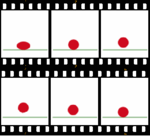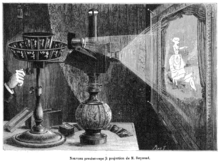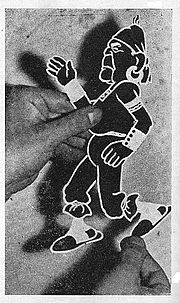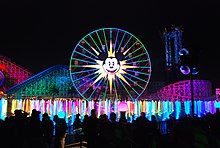Animation
Etymology[edit]
History[edit]
Before cinematography[edit]
Silent era[edit]
American golden age[edit]
Features before CGI[edit]
Television[edit]
Switch from cels to computers[edit]
Economic status[edit]
Education, propaganda and commercials[edit]
Other media, merchandise and theme parks[edit]
Criticism[edit]
Awards[edit]
Academy Awards[edit]
Production[edit]
Techniques[edit]
Traditional[edit]
Full[edit]
Limited[edit]
Rotoscoping[edit]
Live-action blending[edit]
Stop motion[edit]
- Puppet animation
- Typically involves stop-motion puppet figures interacting in a constructed environment, in contrast to real-world interaction in model animation.[61] The puppets generally have an armature inside of them to keep them still and steady to constrain their motion to particular joints.[62] Examples include The Tale of the Fox (France, 1937), The Nightmare Before Christmas (US, 1993), Corpse Bride (US, 2005), Coraline (US, 2009), the films of Jiří Trnka and the adult animated sketch-comedy television series Robot Chicken (US, 2005–present).
- Clay animation or Plasticine animation
- (Often called claymation, which, however, is a trademarked name). It uses figures made of clay or a similar malleable material to create stop-motion animation.[59][65] The figures may have an armature or wire frame inside, similar to the related puppet animation (below), that can be manipulated to pose the figures.[66] Alternatively, the figures may be made entirely of clay, in the films of Bruce Bickford, where clay creatures morph into a variety of different shapes. Examples of clay-animated works include The Gumby Show (US, 1957–1967), Mio Mao (Italy, 1974–2005), Morph shorts (UK, 1977–2000), Wallace and Gromit shorts (UK, as of 1989), Jan Švankmajer's Dimensions of Dialogue (Czechoslovakia, 1982), The Trap Door (UK, 1984). Films include Wallace & Gromit: The Curse of the Were-Rabbit, Chicken Run and The Adventures of Mark Twain.[67]
- Strata-cut animation
- Most commonly a form of clay animation in which a long bread-like "loaf" of clay, internally packed tight and loaded with varying imagery, is sliced into thin sheets, with the animation camera taking a frame of the end of the loaf for each cut, eventually revealing the movement of the internal images within.[68]
- Cutout animation
- A type of stop-motion animation produced by moving two-dimensional pieces of material paper or cloth.[69] Examples include Terry Gilliam's animated sequences from Monty Python's Flying Circus (UK, 1969–1974); Fantastic Planet (France/Czechoslovakia, 1973); Tale of Tales (Russia, 1979), The pilot episode of the adult television sitcom series (and sometimes in episodes) of South Park (US, 1997) and the music video Live for the moment, from Verona Riots band (produced by Alberto Serrano and Nívola Uyá, Spain 2014).
- Model animation
- Refers to stop-motion animation created to interact with and exist as a part of a live-action world.[71] Intercutting, matte effects and split screens are often employed to blend stop-motion characters or objects with live actors and settings.[72] Examples include the work of Ray Harryhausen, as seen in films, Jason and the Argonauts (1963),[73] and the work of Willis H. O'Brien on films, King Kong (1933).
- Go motion
- A variant of model animation that uses various techniques to create motion blur between frames of film, which is not present in traditional stop motion.[74] The technique was invented by Industrial Light & Magic and Phil Tippett to create special effect scenes for the film The Empire Strikes Back (1980).[75] Another example is the dragon named "Vermithrax" from the 1981 film Dragonslayer.[76]
- Object animation
- Refers to the use of regular inanimate objects in stop-motion animation, as opposed to specially created items.[77]
- Graphic animation
- Uses non-drawn flat visual graphic material (photographs, newspaper clippings, magazines, etc.), which are sometimes manipulated frame by frame to create movement.[78] At other times, the graphics remain stationary, while the stop-motion camera is moved to create on-screen action.
- Brickfilm
- A subgenre of object animation involving using Lego or other similar brick toys to make an animation.[79][80] These have had a recent boost in popularity with the advent of video sharing sites, YouTube and the availability of cheap cameras and animation software.[81]
- Pixilation
- Involves the use of live humans as stop-motion characters.[82] This allows for a number of surreal effects, including disappearances and reappearances, allowing people to appear to slide across the ground, and other effects.[82] Examples of pixilation include The Secret Adventures of Tom Thumb and Angry Kid shorts, and the Academy Award-winning Neighbours by Norman McLaren.
Computer[edit]
2D[edit]
3D[edit]
Terms[edit]
- Cel-shaded animation is used to mimic traditional animation using computer software.[99] The shading looks stark, with less blending of colors. Examples include Skyland (2007, France), The Iron Giant (1999, United States), Futurama (1999, United States) Appleseed Ex Machina (2007, Japan), The Legend of Zelda: The Wind Waker (2002, Japan), The Legend of Zelda: Breath of the Wild (2017, Japan)
- Machinima – Films created by screen capturing in video games and virtual worlds. The term originated from the software introduction in the 1980s demoscene, as well as the 1990s recordings of the first-person shooter video game Quake.
- Motion capture is used when live-action actors wear special suits that allow computers to copy their movements into CG characters.[100][101] Examples include Polar Express (2004, US), Beowulf (2007, US), A Christmas Carol (2009, US), The Adventures of Tintin (2011, US) kochadiiyan (2014, India)
- Computer animation is used primarily for animation that attempts to resemble real life, using advanced rendering that mimics in detail skin, plants, water, fire, clouds, etc.[102] Examples include Up (2009, US), How to Train Your Dragon (2010, US)
- Physically based animation is animation using computer simulations.[103]
Mechanical[edit]
- Animatronics is the use of mechatronics to create machines that seem animate rather than robotic.
- Audio-Animatronics and Autonomatronics is a form of robotics animation, combined with 3-D animation, created by Walt Disney Imagineering for shows and attractions at Disney theme parks move and make noise (generally a recorded speech or song).[104] They are fixed to whatever supports them. They can sit and stand, and they cannot walk. An Audio-Animatron is different from an android-type robot in that it uses prerecorded movements and sounds, rather than responding to external stimuli. In 2009, Disney created an interactive version of the technology called Autonomatronics.[105]
- Linear Animation Generator is a form of animation by using static picture frames installed in a tunnel or a shaft. The animation illusion is created by putting the viewer in a linear motion, parallel to the installed picture frames.[106] The concept and the technical solution were invented in 2007 by Mihai Girlovan in Romania.
- Chuckimation is a type of animation created by the makers of the television series Action League Now! in which characters/props are thrown, or chucked from off camera or wiggled around to simulate talking by unseen hands.[107]
- The magic lantern used mechanical slides to project moving images, probably since Christiaan Huygens invented this early image projector in 1659.
Other[edit]
- Hydrotechnics: a technique that includes lights, water, fire, fog, and lasers, with high-definition projections on mist screens.
- Drawn on film animation: a technique where footage is produced by creating the images directly on film stock; for example, by Norman McLaren,[108] Len Lye and Stan Brakhage.
- Paint-on-glass animation: a technique for making animated films by manipulating slow drying oil paints on sheets of glass,[109] for example by Aleksandr Petrov.
- Erasure animation: a technique using traditional 2D media, photographed over time as the artist manipulates the image. For example, William Kentridge is famous for his charcoal erasure films,[110] and Piotr Dumała for his auteur technique of animating scratches on plaster.
- Pinscreen animation: makes use of a screen filled with movable pins that can be moved in or out by pressing an object onto the screen.[111] The screen is lit from the side so that the pins cast shadows. The technique has been used to create animated films with a range of textural effects difficult to achieve with traditional cel animation.[112]
- Sand animation: sand is moved around on a back- or front-lighted piece of glass to create each frame for an animated film.[113] This creates an interesting effect when animated because of the light contrast.[114]
- Flip book: a flip book (sometimes, especially in British English, called a flick book) is a book with a series of pictures that vary gradually from one page to the next, so that when the pages are turned rapidly, the pictures appear to animate by simulating motion or some other change.[115][116] Flip books are often illustrated books for children,[117] they also are geared towards adults and employ a series of photographs rather than drawings. Flip books are not always separate books, they appear as an added feature in ordinary books or magazines, often in the page corners.[115] Software packages and websites are also available that convert digital video files into custom-made flip books.[118]
- Character animation
- Multi-sketching
- Special effects animation
See also[edit]
- Twelve basic principles of animation
- Animated war film
- Animation department
- Animated series
- Architectural animation
- Avar
- Independent animation
- International Animation Day
- International Animated Film Association
- International Tournée of Animation
- List of film-related topics
- Motion graphic design
- Society for Animation Studies
- Wire-frame model
References[edit]
Citations[edit]
- ^ a b c Buchan 2013.
- ^ "The definition of animation on dictionary.com".
- ^ Solomon 1989, p. 28.
- ^ Solomon 1989, p. 24.
- ^ Solomon 1989, p. 34.
- ^ Bendazzi 1994, p. 49.
- ^ * Total prior to 50th anniversary reissue: Culhane, John (12 July 1987). "'Snow White' At 50: Undimmed Magic". The New York Times. Archived from the original on 4 June 2014. Retrieved 29 June 2014.
By now, it has grossed about $330 million worldwide - so it remains one of the most popular films ever made.
- ^ * 1987 and 1993 grosses from North America: "Snow White and the Seven Dwarfs – Releases". Box Office Mojo. Archived from the original on 29 May 2014. Retrieved 29 June 2014.
1987 release – $46,594,212; 1993 release – $41,634,471
- ^ "First fully digital feature film". Guinness World Records. Guinness World Records Limited. Retrieved 27 December 2018.
- ^ Amidi, Amid (1 June 2015). "Sergio Pablos Talks About His Stunning Hand-Drawn Project 'Klaus'". Cartoon Brew. Retrieved 12 October 2019.
- ^ "The Origins of Klaus". YouTube. 10 October 2019. Archived from the original on 22 November 2021. Retrieved 12 October 2019.
- ^ Bernstein, Abbie (25 February 2013). "Assignment X". Exclusive Interview: John Kahrs & Kristina Reed on PAPERMAN. Midnight Productions, Inc. Retrieved 6 October 2013.
- ^ "FIRST LOOK: Disney's 'Paperman' fuses hand-drawn charm with digital depth". EW.com. Retrieved 2 October 2014.
- ^ Sarto, Dan. "Inside Disney's New Animated Short Paperman". Animation World Network. Retrieved 5 June 2012.
- ^ "Disney's Paperman animated short fuses CG and hand-drawn techniques". Retrieved 2 October 2014.
- ^ Board of Investments 2009.
- ^ "Global animation market value 2017-2020". Statista. Retrieved 31 March 2022.
- ^ McDuling 2014.
- ^ "Snap, Crackle, Pop® | Rice Krispies®". www.ricekrispies.com. Retrieved 16 June 2020.
- ^ Taylor, Heather (10 June 2019). "The Raid Bugs: Characters We Love To Hate". PopIcon.life. Retrieved 16 June 2020.
- ^ Amidi 2011.
- ^ Nagel 2008.
- ^ Laybourne 1998, p. 117.
- ^ Solomon 1989, p. 274.
- ^ White 2006, p. 151.
- ^ Laybourne 1998, p. 339.
- ^ Culhane 1990, p. 55.
- ^ Solomon 1989, p. 120.
- ^ Laybourne 1998, pp. 100–01.
- ^ Masson 2007, p. 94.
- ^ Beck 2004, p. 37.
- ^ a b Williams 2001, p. 34.
- ^ Culhane 1990, p. 146.
- ^ a b Williams 2001, pp. 52–57.
- ^ Laybourne 1998, pp. 99–100.
- ^ White 2006, p. 31.
- ^ Beckerman 2003, p. 153.
- ^ Thomas & Johnston 1981, pp. 277–79.
- ^ Laybourne 1998, p. 203.
- ^ White 2006, pp. 195–201.
- ^ White 2006, p. 394.
- ^ a b Culhane 1990, p. 296.
- ^ Laybourne 1998, pp. 35–36, 52–53.
- ^ Solomon 1989, pp. 63–65.
- ^ Beckerman 2003, p. 80.
- ^ Culhane 1990, p. 71.
- ^ Culhane 1990, pp. 194–95.
- ^ Laybourne 1998, pp. 25–26.
- ^ Beckerman 2003, p. 142.
- ^ Beckerman 2003, pp. 54–55.
- ^ Ledoux 1997, p. 24, 29.
- ^ Lawson & Persons 2004, p. 82.
- ^ Solomon 1989, p. 241.
- ^ Lawson & Persons 2004, p. xxi.
- ^ Crafton 1993, p. 158.
- ^ Laybourne 1998, pp. 163–64.
- ^ Laybourne 1998, pp. 162–63.
- ^ Beck 2004, pp. 18–19.
- ^ a b Solomon 1989, p. 299.
- ^ a b Laybourne 1998, p. 159.
- ^ Solomon 1989, p. 171.
- ^ Laybourne 1998, pp. 155–56.
- ^ Beck 2004, p. 70.
- ^ Beck 2004, pp. 92–93.
- ^ Laybourne 1998, pp. 150–151.
- ^ Laybourne 1998, pp. 151–54.
- ^ Beck 2004, p. 250.
- ^ Furniss 1998, pp. 52–54.
- ^ Laybourne 1998, pp. 59–60.
- ^ Culhane 1990, pp. 170–171.
- ^ Harryhausen & Dalton 2008, pp. 9–11.
- ^ Harryhausen & Dalton 2008, pp. 222–26
- ^ Harryhausen & Dalton 2008, p. 18
- ^ Smith 1986, p. 90.
- ^ Watercutter 2012.
- ^ Smith 1986, pp. 91–95.
- ^ Laybourne 1998, pp. 51–57.
- ^ Laybourne 1998, p. 128.
- ^ Paul 2005, pp. 357–63.
- ^ Herman 2014.
- ^ Haglund 2014.
- ^ a b Laybourne 1998, pp. 75–79.
- ^ Serenko 2007.
- ^ Masson 2007, p. 405.
- ^ Serenko 2007, p. 482.
- ^ Masson 2007, p. 165.
- ^ Sito 2013, pp. 32, 70, 132.
- ^ Priebe 2006, pp. 71–72.
- ^ White 2006, p. 392.
- ^ Lowe & Schnotz 2008, pp. 246–47.
- ^ Masson 2007, pp. 127–28.
- ^ Beck 2012.
- ^ a b Masson 2007, p. 88.
- ^ Sito 2013, p. 208.
- ^ Masson 2007, pp. 78–80.
- ^ Sito 2013, p. 285.
- ^ Masson 2007, p. 96.
- ^ Lowe & Schnotz 2008, p. 92.
- ^ "Cel Shading: the Unsung Hero of Animation?". Animator Mag. 17 December 2011. Archived from the original on 5 March 2016. Retrieved 20 February 2016.
- ^ Sito 2013, pp. 207–08.
- ^ Masson 2007, p. 204.
- ^ Parent 2007, p. 19.
- ^ Donald H. House; John C. Keyser (30 November 2016). Foundations of Physically Based Modeling and Animation. CRC Press. ISBN 978-1-315-35581-8.
- ^ Pilling 1997, p. 249.
- ^ O'Keefe 2014.
- ^ Parent 2007, pp. 22–23.
- ^ Kenyon 1998.
- ^ Faber & Walters 2004, p. 1979.
- ^ Pilling 1997, p. 222.
- ^ Carbone 2010.
- ^ Neupert 2011.
- ^ Pilling 1997, p. 204.
- ^ Brown 2003, p. 7.
- ^ Furniss 1998, pp. 30–33.
- ^ a b Laybourne 1998, pp. 22–24.
- ^ Solomon 1989, pp. 8–10.
- ^ Laybourne 1998, p. xiv.
- ^ White 2006, p. 203.
Sources[edit]
Journal articles[edit]
- Anderson, Joseph and Barbara (Spring 1993). "Journal of Film and Video". The Myth of Persistence of Vision Revisited. 45 (1): 3–13. Archived from the original on 24 November 2009.
- Serenko, Alexander (2007). "Computers in Human Behavior" (PDF). The Development of an Instrument to Measure the Degree of Animation Predisposition of Agent Users. 23 (1): 478–95.
Books[edit]
- Baer, Eva (1983). Metalwork in Medieval Islamic Art. State University of New York Press. pp. 58, 86, 143, 151, 176, 201, 226, 243, 292, 304. ISBN 978-0-87395-602-4.
- Beck, Jerry (2004). Animation Art: From Pencil to Pixel, the History of Cartoon, Anime & CGI. Fulhamm London: Flame Tree Publishing. ISBN 978-1-84451-140-2.
- Beckerman, Howard (2003). Animation: The Whole Story. Allworth Press. ISBN 978-1-58115-301-9.
- Bendazzi, Giannalberto (1994). Cartoons: One Hundred Years of Cinema Animation. Bloomington, Indiana: Indiana University Press. ISBN 978-0-253-20937-5.
- Buchan, Suzanne (2013). Pervasive Animation. New York and London: Routledge. ISBN 978-0-415-80723-4.
- Canemaker, John (2005). Winsor McCay: His Life and Art (Revised ed.). Abrams Books. ISBN 978-0-8109-5941-5.
- Cotte, Olivier (2007). Secrets of Oscar-winning Animation: Behind the scenes of 13 classic short animations. Focal Press. ISBN 978-0240520704.
- Crafton, Donald (1993). Before Mickey: The Animated Film 1898–1928. Chicago: University of Chicago Press. ISBN 978-0-226-11667-9.
- Culhane, Shamus (1990). Animation: Script to Screen. St. Martin's Press. ISBN 978-0-312-05052-8.
- Drazin, Charles (2011). The Faber Book of French Cinema. Faber & Faber. ISBN 978-0-571-21849-3.
- Faber, Liz; Walters, Helen (2004). Animation Unlimited: Innovative Short Films Since 1940. London: Laurence King Publishing. ISBN 978-1-85669-346-2.
- Finkielman, Jorge (2004). The Film Industry in Argentina: An Illustrated Cultural History. North Carolina: McFarland. p. 20. ISBN 978-0-7864-1628-8.
- Furniss, Maureen (1998). Art in Motion: Animation Aesthetics. Indiana University Press. ISBN 978-1-86462-039-9.
- Godfrey, Bob; Jackson, Anna (1974). The Do-It-Yourself Film Animation Book. BBC Publications. ISBN 978-0-563-10829-0.
- Harryhausen, Ray; Dalton, Tony (2008). A Century of Model Animation: From Méliès to Aardman. Aurum Press. ISBN 978-0-8230-9980-1.
- Herman, Sarah (2014). Brick Flicks: A Comprehensive Guide to Making Your Own Stop-Motion LEGO Movies. New York: Skyhorse Publishing. ISBN 978-1-62914-649-2.
- Lawson, Tim; Persons, Alisa (2004). The Magic Behind the Voices [A Who's Who of Cartoon Voice Actors]. University Press of Mississippi. ISBN 978-1-57806-696-4.
- Laybourne, Kit (1998). The Animation Book: A Complete Guide to Animated Filmmaking – from Flip-books to Sound Cartoons to 3-D Animation. New York: Three Rivers Press. ISBN 978-0-517-88602-1.
- Ledoux, Trish (1997). Complete Anime Guide: Japanese Animation Film Directory and Resource Guide. Tiger Mountain Press. ISBN 978-0-9649542-5-0.
- Lowe, Richard; Schnotz, Wolfgang, eds. (2008). Learning with Animation. Research implications for design. New York: Cambridge University Press. ISBN 978-0-521-85189-3.
- Masson, Terrence (2007). CG101: A Computer Graphics Industry Reference. Unique and personal histories of early computer animation production, plus a comprehensive foundation of the industry for all reading levels. Williamstown, MA: Digital Fauxtography. ISBN 978-0-9778710-0-1.
- Needham, Joseph (1962). "Science and Civilization in China". Physics and Physical Technology. Vol. IV. Cambridge University Press.
- Neupert, Richard (2011). French Animation History. John Wiley & Sons. ISBN 978-1-4443-3836-2.
- Parent, Rick (2007). Computer Animation: Algorithms & Techniques. Ohio State University: Morgan Kaufmann. ISBN 978-0-12-532000-9.
- Paul, Joshua (2005). Digital Video Hacks. O'Reilly Media. ISBN 978-0-596-00946-5.
- Pilling, Jayne (1997). Society of Animation Studies (ed.). A Reader in Animation Studies. Indiana University Press. ISBN 978-1-86462-000-9.
- Priebe, Ken A. (2006). The Art of Stop-Motion Animation. Thompson Course Technology. ISBN 978-1-59863-244-6.
- Rojas, Carlos; Chow, Eileen (2013). The Oxford Handbook of Chinese Cinemas. Oxford University Press. ISBN 978-0-19-998844-0.
- Sammond, Nicholas (27 August 2015). Birth of an Industry: Blackface Minstrelsy and the Rise of American Animation. Durham, NC: Duke University Press. doi:10.1515/9780822375784. ISBN 9780822358527. OCLC 8605897837.
- Shaffer, Joshua C. (2010). Discovering The Magic Kingdom: An Unofficial Disneyland Vacation Guide. Indiana: Author House. ISBN 978-1-4520-6312-6.
- Sito, Tom (2013). Moving Innovation: A History of Computer Animation. Massachusetts: MIT Press. ISBN 978-0-262-01909-5.
- Solomon, Charles (1989). Enchanted Drawings: The History of Animation. New York: Random House, Inc. ISBN 978-0-394-54684-1.
- Thomas, Bob (1958). Walt Disney, the Art of Animation: The Story of the Disney Studio Contribution to a New Art. Walt Disney Studios. Simon and Schuster.
- Thomas, Frank; Johnston, Ollie (1981). Disney Animation: The Illusion of Life. Abbeville Press. ISBN 978-0-89659-233-9.
- Smith, Thomas G. (1986). Industrial Light & Magic: The Art of Special Effects. New York: Ballantine Books. ISBN 978-0-345-32263-0.
- White, Tony (2006). Animation from Pencils to Pixels: Classical Techniques for the Digital Animator. Milton Park: Taylor & Francis. ISBN 978-0-240-80670-9.
- Williams, Richard (2001). The Animator's Survival Kit. Faber and Faber. ISBN 978-0-571-20228-7.
- Zielinski, Siegfried (1999). Audiovisions: Cinema and Television as Entr'actes in History. Amsterdam University Press. ISBN 978-90-5356-303-8.
Online sources[edit]
- Amidi, Amid (2 December 2011). "NY Film Critics Didn't like a Single Animated Film This Year". Cartoon Brew. Retrieved 19 February 2016.
- Ball, Ryan (12 March 2008). "Oldest Animation Discovered in Iran". Animation Magazine. Retrieved 15 March 2016.
- Beck, Jerry (2 July 2012). "A Little More About Disney's "Paperman"". Cartoon Brew.
- Bendazzi, Giannalberto (1996). "The Untold Story of Argentina's Pioneer Animator". Animation World Network. Retrieved 29 April 2016.
- "Animation" (PDF). boi.gov.ph. Board of Investments. November 2009. Archived from the original (PDF) on 19 October 2012. Retrieved 24 July 2012.
- Brown, Margery (2003). "Experimental Animation Techniques" (PDF). Olympia, WA: Evergreen State Collage. Archived from the original (PDF) on 7 March 2008. Retrieved 11 November 2005.
- Carbone, Ken (24 February 2010). "Stone-Age Animation in a Digital World: William Kentridge at MoMA". Fast Company. Retrieved 7 March 2016.
- Haglund, David (7 February 2014). "The Oldest Known LEGO Movie". Slate. Retrieved 25 February 2016.
- "World's Oldest Animation?". theheritagetrust.wordpress.com. The Heritage Trust. 25 July 2012. Archived from the original on 22 October 2015.
- Kenyon, Heather (1 February 1998). "How'd They Do That?: Stop-Motion Secrets Revealed". Animation World Network. Retrieved 2 March 2016.
- Nagel, Jan (21 May 2008). "Gender in Media: Females Don't Rule". Animation World Network. Retrieved 3 March 2016.
- McDuling, John (3 July 2014). "Hollywood Is Giving Up on Comedy". The Atlantic. The Atlantic Monthly Group. Retrieved 20 July 2014.
- McLaughlin, Dan (2001). "A Rather Incomplete But Still Fascinating". Film TV. UCLA. Archived from the original on 19 November 2009. Retrieved 12 February 2013.
- O'Keefe, Matt (11 November 2014). "6 Major Innovations That Sprung from the Heads of Disney Imagineers". Theme Park Tourist. Retrieved 9 March 2016.
- Watercutter, Angela (24 May 2012). "35 Years After Star Wars, Effects Whiz Phil Tippett Is Slowly Crafting a Mad God". Wired. Retrieved 6 February 2016.
- Zohn, Patricia (28 February 2010). "Coloring the Kingdom". Vanity Fair. Retrieved 7 December 2015.
- "Walt Disney's Oscars". The Walt Disney Family Museum. 22 February 2013. Archived from the original on 22 March 2015. Retrieved 22 February 2016.
- "Władysław Starewicz – Biography". culture.pl. Adam Mickiewicz Institute. 16 April 2012. Retrieved 9 February 2016.
External links[edit]
| Library resources about Animation |









.png)
.png)

















